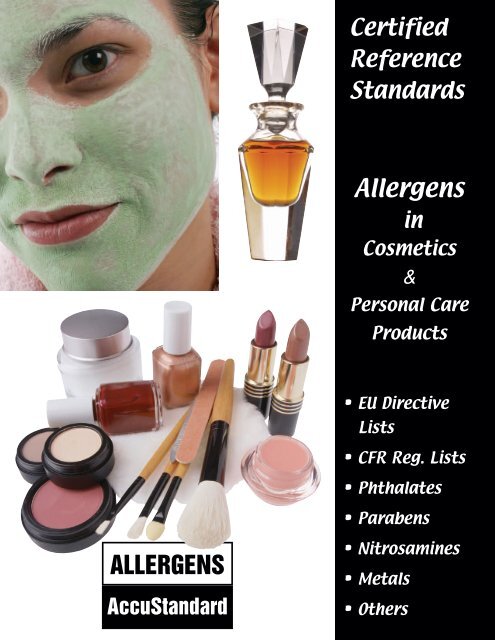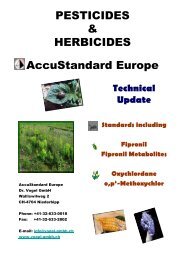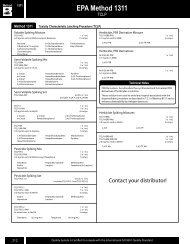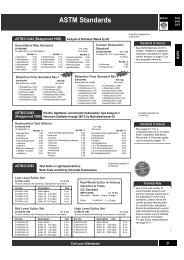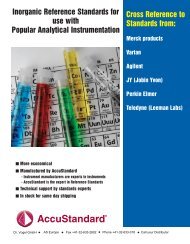Allergens by AccuStandard - Dr. Vogel GmbH
Allergens by AccuStandard - Dr. Vogel GmbH
Allergens by AccuStandard - Dr. Vogel GmbH
Create successful ePaper yourself
Turn your PDF publications into a flip-book with our unique Google optimized e-Paper software.
ALLERGENS<br />
<strong>AccuStandard</strong><br />
Certified<br />
Reference<br />
Standards<br />
<strong>Allergens</strong><br />
in<br />
Cosmetics<br />
&<br />
Personal Care<br />
Products<br />
• EU Directive<br />
Lists<br />
• CFR Reg. Lists<br />
• Phthalates<br />
• Parabens<br />
• Nitrosamines<br />
• Metals<br />
• Others
<strong>Allergens</strong> <strong>by</strong> <strong>AccuStandard</strong> ®<br />
Of all the chemicals found in the environment today, only a small portion has been tested for toxicity. “Of the<br />
10,500 chemical ingredients used in personal care products, only 11 percent have been safety assessed (including<br />
their allergen properties) and the assessments were not conducted <strong>by</strong> government officials, but <strong>by</strong> a panel funded<br />
<strong>by</strong> manufacturers” 1 . Further, it is alarming to note that, “chemicals in combinations of two or more can create a<br />
synergy, making the toxicity significantly higher than any of the individual chemicals” 2 . This is of concern<br />
because,“one-quarter of all women use at least 15 (personal-care) products a day” 3 .<br />
“In addition to allergens, cosmetics and toiletries contain numerous other hazardous ingredients, including almost<br />
100 carcinogens and 15 endocrine (hormonal) disrupters, particularly phthalates” 4 .<br />
Did you know?<br />
• 10% of the U.S. population is affected <strong>by</strong> allergens 5 .<br />
• The Institute of Medicine placed fragrance in the same category as secondhand smoke in<br />
triggering asthma in adults and school-age children 6 .<br />
• 5,000 is the approximate number of different fragrances in cosmetics 7 .<br />
• 1/3 is the percentage of cosmetic and toiletry products that contain chemicals (including<br />
fragrances) which have been linked to cancer 8 .<br />
The cosmetic known as “ceruse” was used <strong>by</strong> wealthy women in Europe from the 2nd century until well into the<br />
19th century in order to make their faces look fashionably pale. Unfortunately, this was a fatal vanity because<br />
ceruse is essentially white lead 9 .<br />
Pale is not currently chic, but using sun block is. However, common ingredients in sun blocks, such as PABA and<br />
4-MBC, are now a health concern. An answer to address this concern is to increase the awareness and<br />
understanding of the effects of common chemicals. This awareness has already happened as is evidenced <strong>by</strong><br />
increasing governmental and industrial (self-regulation) actions.<br />
The European Union has banned Phthalates from cosmetics 10 . The European Parliament, through the SCCNFP, has<br />
limited the use of cosmetic allergens and has proposed the banning of 36 more. The $124 billion a year cosmetics<br />
industry will be required to reformulate their products for EU consumers <strong>by</strong> September 2004. Many companies —<br />
such as The Body Shop, Urban Decay, and OSEA Skin Care — have already begun to remove these chemicals<br />
from their products or pledged to do so 11 .<br />
In the U.S., Senator Edward Kennedy (D-MA) has been asked <strong>by</strong> environmental organizations to consider<br />
legislation mandating labeling for cosmetics and toiletries that pose serious, irreversible health risks 12 .<br />
Representative Jan Schakowsky, D-IL, has reintroduced legislation, “The Safe Notification and Information<br />
for Fragrances (SNIFF) Act,” to amend the Food, <strong>Dr</strong>ug, and Cosmetic Act. The Act requires that <strong>Allergens</strong><br />
in fragrance products be labeled accordingly. More explicitly, the European Parliament has issued a<br />
Directive that all products containing 26 well-known <strong>Allergens</strong> should be labeled 13 . In another effort,<br />
California Bill AB 2025 seeks to prohibit dangerous chemicals in cosmetics 14 . All this will lead to increased<br />
testing to meet the new criteria.<br />
©<strong>AccuStandard</strong> 2004<br />
<strong>AccuStandard</strong> Europe<br />
Standards are our Life<br />
E-mail: info@vogel-gmbh.ch<br />
www.vogel-gmbh.ch<br />
<strong>Dr</strong>. <strong>Vogel</strong> <strong>GmbH</strong><br />
Walliswilweg 2<br />
CH-4704 Niederbipp<br />
Phone +41-32-633-0018<br />
Fax +41-32-633-2802<br />
ISO 9001:2000<br />
Certificate Number: 31692
Allergen standards offered <strong>by</strong> <strong>AccuStandard</strong>:<br />
Standards include those found in everything from shampoos to skin creams. Since personal care products have<br />
proliferated, we look better and smell better. However, the average person is now exposed to significantly higher<br />
levels of chemicals than people were exposed to only a generation ago. The resulting synergistic effect, coupled<br />
with environmental exposure to chemicals, is the focus of an ever increasing number of studies.<br />
Some of these chemicals cause, or are suspected of causing, allergic reactions. Some chemicals are toxic.<br />
Phthalates are a cosmetic issue as well as a Food Safety concern as an Indirect Food Additive. They tend to<br />
migrate from plastic containers and wrappings into food. Finally, pesticides are a cosmetic ingredient issue since<br />
they can be present with other ingredients such as lanolin. <strong>AccuStandard</strong> offers the widest selection of Certified<br />
Reference Standards for pesticide and pesticide metabolite analysis (see www. <strong>AccuStandard</strong>.com for a full list).<br />
The Standards were introduced <strong>by</strong> <strong>AccuStandard</strong> to meet analytical requirements.<br />
Three Reasons to buy cosmetic Standards from <strong>AccuStandard</strong> instead of making them in your own lab:<br />
1. Safety The less exposure to concentrated chemicals, the fewer safety issues a company will have.<br />
2. Certification Full Certificates of Analysis come with all products. <strong>AccuStandard</strong>’s quality system is<br />
ISO 9001:2000 accredited. <strong>AccuStandard</strong> is the only major organic standards manufacturer to be<br />
approved <strong>by</strong> NIST (under the NVLAP Program, Lab Code 200389-0) as a Proficiency Test (PT) provider.<br />
3. Savings Buying and manufacturing efficiencies along with storage and disposal issues make it more<br />
cost effective to get your standards from <strong>AccuStandard</strong>.<br />
<strong>AccuStandard</strong> is the largest manufacturer dedicated solely to the synthesis, manufacture and analysis of certified<br />
chemical reference standards in the world. Known for its synthesis of all 209 PCB congeners, over 130 PBDE<br />
congeners, and almost all of the more important POPs (Persistent Organic Pollutants), <strong>AccuStandard</strong>’s selection of<br />
over 30,000 standards is the widest available. All standards ship with Certificates of Analysis.<br />
Many Standards are synthesized <strong>by</strong> <strong>AccuStandard</strong> and are not available elsewhere. If you do not see the chemicals<br />
or their metabolites that you need, let us know and we may be able to synthesize them. Additionally, if a certain<br />
custom mixture of allergens would make your analysis easier, we can provide you with a custom formulation that<br />
will save you time.<br />
References:<br />
1 www.healthy-communications.com/6-04envcosmeticnews.html<br />
2 www.mindfully.org/Pesticide/2002/Chemical-Stats.htm<br />
3 www.healthy-communications.com/6-04usatodaycosmetics.html<br />
4 www.healthy-communications.com/02-8AS-label-allergens.htm<br />
5 www.health.discovery.com/centers/allergyasthma/allergy/living2.html<br />
6 www.fpinva.org/<br />
7 www.health.discovery.com/centers/allergyasthma/allergy/living2.html<br />
8 www.healthy-communications.com/04-6-14cosmeticdangers.html<br />
9 http://allallergy.net/articles/index.cfm/cdeoc/PU/entered/z/rview/z/whom/z/tingra/1/page/p3<br />
10 www.organicconsumers.org/bodycare/fda060104.cfm<br />
11 www.healthy-communications.com/04cosmeticregulationstobechanged.html<br />
12 www.healthy-communications.com/02-8AS-label-allergens.htm<br />
13 www.ascribe.org/cgi-bin/spew4th.pl?ascribid=20040806.095645&time=10%2034%20PDT&year=plblic=1<br />
14 www.healthy-communications.com/04cosmeticregulationstobechanged.html<br />
<strong>AccuStandard</strong> Europe - <strong>Dr</strong>. <strong>Vogel</strong> <strong>GmbH</strong><br />
Call Your Distributor<br />
Phone 0041-32-633-0018 Fax 0041-32-633-2802 www.vogel-gmbh.ch
<strong>Allergens</strong> listed in the EU Directive<br />
EU Directive 76/768/EEC, Annex VIII (a), the work of the Scientific Committee on Cosmetic Products and Non-Food Products (SCCNFP),<br />
identified 26 fragrance allergens. They include cut-off levels beyond which the products must be labeled. These levels are 0.01% for rinse-off<br />
products and 0.001% for leave-on products. These allergens are also of concern outside the EU. The Directive lists another 36 allergens that may be<br />
banned, 28 are currently available.<br />
Each is 1 mL at 1000 µg/mL. For Solvent see Key<br />
EU DIRECTIVE LIST OF 26 REGULATED CONTACT ALLERGENS<br />
CAS # Cat. No.<br />
Amyl cinnamal 122-40-7 ALR-001S-CN-10X<br />
Benzyl alcohol 100-51-6 ALR-002S-ET-10X<br />
Cinnamyl alcohol 104-54-1 ALR-003S-ET-10X<br />
Citral 5392-40-5 ALR-004S-CN-10X<br />
Eugenol 97-53-0 ALR-005S-ET-10X<br />
Hydroxy-citronellal 107-75-5 ALR-006S-CN-10X<br />
Isoeugenol 97-54-1 ALR-007S-ET-10X<br />
Amylcinnamyl alcohol 101-85-9 ALR-008S-ET-10X<br />
Benzyl salicylate 118-58-1 ALR-009S-ET-10X<br />
Cinnamal 104-55-2 ALR-010S-CN-10X<br />
Coumarin 91-64-5 ALR-011S-CN-10X<br />
Geraniol 106-24-1 ALR-012S-ET-10X<br />
Hydroxymethylpentylcyclohexenecarboxaldehyde 31906-04-4 ALR-013S-CN-10X<br />
Anisyl alcohol 105-13-5 ALR-014S-ET-10X<br />
Benzyl cinnamate 103-41-3 ALR-015S-ET-10X<br />
Farnesol 4602-84-0 ALR-016S-ET-10X<br />
2-(4-tert-Butylbenzyl)propionaldehyde 80-54-6 ALR-017S-CN-10X<br />
Linalool 78-70-6 ALR-018S-ET-10X<br />
Benzyl benzoate 120-51-4 ALR-019S-ET-10X<br />
Citronellol 106-22-9 ALR-020S-ET-10X<br />
Hexyl cinnamaldehyde 101-86-0 ALR-021S-ET-10X<br />
d-Limonene 5989-27-5 ALR-022S-ET-10X<br />
Methylheptin carbonate 111-12-6 ALR-023S-ET-10X<br />
Cetone Alpha 127-51-5 ALR-024S-CN-10X<br />
Tree Moss N/A ALR-025S-ET-10X<br />
Oak Moss N/A ALR-026S-ET-10X<br />
Set of all 26 EU <strong>Allergens</strong> ALR-EU26-SET 26 x 1 mL<br />
®<br />
<strong>AccuStandard</strong> Europe - <strong>Dr</strong>. <strong>Vogel</strong> <strong>GmbH</strong><br />
Each is 1 mL at 1000 µg/mL. For Solvent see Key<br />
EU DIRECTIVE LIST THAT MAY BE BANNED:<br />
CAS # Cat. No.<br />
Alanroot (Inula helenium) 97676-35-2 ALR-027S-ET-10X<br />
Allylisothiocyanate 57-06-7 ALR-028S-ET-10X<br />
Benzyl cyanide 140-29-4 ALR-029S-ET-10X<br />
p-tert-Butylphenol 98-54-4 ALR-030S-ET-10X<br />
(Wormseed oil)<br />
Diethyl maleate 141-05-9 ALR-033S-ET-10X<br />
Dihydrocoumarin 119-84-6 ALR-034S-A-10X<br />
(6,7-Dihydrogeraniol)<br />
Dimethyl citraconate 617-54-9 ALR-038S-ET-10X<br />
6,10-Dimethyl-3,5,9-undecatrien-2-one 141-10-6 ALR-040S-A-10X<br />
(Pseudoionone)<br />
Diphenylamine 122-39-4 ALR-041S-ET-10X<br />
Ethyl acrylate 140-88-5 ALR-042S-ET-10X<br />
trans-2-Heptenal 18829-55-5 ALR-044S-CN-10X<br />
trans-2-Hexenal diethyl acetal 67746-30-9 ALR-045S-ET-10X<br />
trans-2-Hexenal dimethyl acetal 18318-83-7 ALR-046S-10X<br />
Hydroabietyl alcohol 13393-93-6 ALR-047S-ET-10X<br />
Hydroquinone monoethyl ether 622-62-8 ALR-048S-ET-10X<br />
(4-Ethoxyphenol)<br />
7-Methoxycoumarin 531-59-9 ALR-050S-CN-10X<br />
4-(p-Methoxyphenyl)-3-butene-2-one 943-88-4 ALR-051S-CN-10X<br />
1-(p-Methoxyphenyl)-1-penten-3-one 104-27-8 ALR-052S-CN-10X<br />
Methyl trans-2-butenoate 623-43-8 ALR-053S-10X<br />
7-Methylcoumarin 2445-83-2 ALR-054S-CN-10X<br />
5-Methyl-2,3-hexanedione 13706-86-0 ALR-055S-CN-10X<br />
(Acetyl isovaleryl)<br />
Musk Ambrette (solution only) 83-66-9 ALR-056S-CN-10X<br />
4-Phenyl-3-buten-2-one 122-57-6 ALR-058S-CN-10X<br />
Verbena oil (Lippia citriodora Kunth) 8024-12-2 ALR-060S-ET-10X<br />
Methyleugenol 95-15-2 ALR-061S-ET-10X<br />
Set of 25 <strong>Allergens</strong> listed above ALR-EU36-R1-SET 25 x 1 mL<br />
For an alphabetical listing of Standards<br />
in this brochure, see last page.<br />
Phone 0041-32-633-0018 Fax 0041-32-633-2802 www.vogel-gmbh.ch<br />
Call Your Distributor
Parabens<br />
Parabens are used as a preservative in a wide range of products including<br />
over 13,200 cosmetics, and even in some foods. Until recently, parabens<br />
were thought to have no serious health risks. Recent testing has indicated<br />
a link between breast tumors and the use of underarm deodorants 15 .<br />
Each is 1 mL at 100 µg/mL. For Solvent see Key<br />
Each is available Neat 100 mg at same price.<br />
Replace “S” with “N” in Cat. No.<br />
Parabens: CAS # Cat. No.<br />
4-Hydroxybenzoic acid (Paraben) 99-96-7 ALR-069S-CN<br />
Benzyl paraben 94-18-8 ALR-083S<br />
Butyl paraben 94-26-8 ALR-085S<br />
Ethyl paraben 120-47-8 ALR-113S<br />
Heptyl paraben 1085-12-7 ALR-117S<br />
Isobutyl paraben 4247-02-3 ALR-121S<br />
Isopropyl paraben 4191-73-5 ALR-122S<br />
Methyl paraben 99-76-3 ALR-130S<br />
Potassium sorbate 24634-61-5 ALR-152S<br />
Propyl paraben 94-13-3 ALR-153S<br />
Protocatechuic acid 3943-89-3 ALR-155S-CN<br />
Reference:<br />
15 http://envirocancer.cornell.edu/Newsletter/General/v9i1/<br />
rc.parabens.cfm<br />
Phthalates †<br />
Phthalates are the most commonly used plasticizers. “In cosmetics they<br />
are used to add texture and luster to the product.” 16 “A 2002 study at<br />
the University of Puerto Rico in San Juan linked phthalates (which are<br />
used to soften plastic) to early puberty in girls. Studies conducted at<br />
Harvard University in Cambridge in 2002 and 2003 linked the<br />
chemicals to decreased sperm counts in men. …a 2002 study <strong>by</strong> the<br />
Atlanta based Center for Disease Control and Prevention, which found<br />
that phthalate levels in young women (who represent the bulk of<br />
cosmetic consumers) may be 20 times higher than average.” 17<br />
Each is 1 mL at 100 µg/mL. For Solvent see Key<br />
Phthalates: CAS # Cat. No.<br />
Benzyl butyl phthalate 85-68-7 ALR-082S<br />
Di(2-ethyl hexyl) phthalate (DEHP) 117-81-7 ALR-097S<br />
Di-amyl phthalate 131-18-0 ALR-098S<br />
Di-cyclohexyl phthalate 84-61-7 ALR-099S<br />
Di-hexyl phthalate 84-75-3 ALR-100S<br />
Di-iso-decyl phthalate 26761-40-0 ALR-101S<br />
Di-iso-nonyl phthalate 68515-48-0 ALR-102S<br />
Di-iso-octyl phthalate 27554-26-3 ALR-103S<br />
Di-n-butyl phthalate (DBP) 84-74-2 ALR-104S<br />
Di-n-octyl phthalate 117-84-0 ALR-105S<br />
Dibutyl phthalate (DBP) 84-74-2 ALR-108S<br />
Diethyl phthalate 84-66-2 ALR-110S<br />
Dimethyl phthalate (DMP) 131-11-3 ALR-111S<br />
Monobenzyl phthalate (mBzP) 2528-1-6 ALR-134S-CN<br />
Monobutyl phthalate (mBP) 131-20-4 ALR-135S-CN<br />
Monoethyl phthalate (mEP) 2306-33-4 ALR-137S-CN<br />
Monoethylhexyl phthalate (mEHP) 4376-20-9 ALR-138S-CN<br />
Monomethyl phthalate 4376-18-5 ALR-139S-CN<br />
References:<br />
16 www.alternet.org/story/13530<br />
17 www.organicconsumers.org/bodycare/fda060104.cfm<br />
† Although not strictly allergens, phthalates in cosmetics are toxic and suspected carcinogens.<br />
Key to Catalog Numbers<br />
N Neat, 100 mg<br />
S Solution in Methanol<br />
S-A Solution in Acetone<br />
S-CN Solution in Acetonitrile<br />
S-ET Solution in Ethanol<br />
S-T Solution in Toluene<br />
S-W Solution in Water<br />
Contact us to get your choice of<br />
concentrations, solvents, or if you<br />
need them neat rather than in solution.<br />
<strong>AccuStandard</strong> Europe - <strong>Dr</strong>. <strong>Vogel</strong> <strong>GmbH</strong> Phone 0041-32-633-0018 Fax 0041-32-633-2802 www.vogel-gmbh.ch<br />
Call Your Distributor
Metals<br />
Many metals, such as Mercury and Chromium, have long been<br />
known to cause health problems. The “mad hatters” of the 19th<br />
century suffered from mercury poisoning, as did the hat makers<br />
in Danbury, Connecticut, who called their disease the Danbury<br />
Shakes 18 . These metals have also found their way into everyday<br />
personal care products.<br />
Each is 100 mL at 1000 µg/mL<br />
METALS: CAS # Solvent Cat. No.<br />
( 100 mL)<br />
Arsenic 7440-38-2 2-5% HNO3 ALR-MET-01S<br />
Chromium 7440-47-3 2-5% HNO3 ALR-MET-02S<br />
Cobalt 7440-48-4 2-5% HNO3 ALR-MET-03S<br />
Lead 7439-92-1 2-5% HNO3 ALR-MET-04S<br />
Mercury 7439-97-6 2-5% HNO3 ALR-MET-05S<br />
Nickel 7440-02-0 2-5% HNO3 ALR-MET-06S<br />
Potassium dichromate 7778-50-9 Water ALR-MET-07S<br />
Zirconium 7440-67-7 2-5% HNO3 ALR-MET-08S<br />
Metals Set: ALR-MET-SET 8 x 100 mL<br />
Reference:<br />
18 www.epa.gov/grtlakes/seahome/mercury/src/effects.htm<br />
Chlorofluorocarbon Propellants †<br />
Each is 1 mL at 200 µg/mL. For Solvent see Key. Solution only.<br />
Chlorofluorocarbon Propellants (CFC): CAS # Cat. No.<br />
Freon #13b1 (Bromotrifluoromethane) 75-63-8 ALR-CFC-001S-2X<br />
Freon #142b (1-Chloro-1,1-difluoroethane) 75-68-3 ALR-CFC-002S-2X<br />
Freon #22 (Chlorodifluoromethane) 75-45-6 ALR-CFC-003S-2X<br />
Freon #160 (Chloroethane) 75-00-3 ALR-CFC-004S-2X<br />
Freon #40 (Chloromethane) 74-87-3 ALR-CFC-005S-2X<br />
Freon #115 (Chloropentafluoroethane) 76-15-3 ALR-CFC-006S-2X<br />
Freon #13 (Chlorotrifluoromethane) 75-72-9 ALR-CFC-007S-2X<br />
Freon #12 (Dichlorodifluoromethane) 75-71-8 ALR-CFC-008S-2X<br />
Freon #21 (Dichlorofluoromethane) 75-43-4 ALR-CFC-009S-2X<br />
Freon #114 76-14-2 ALR-CFC-010S-2X<br />
(1,2-Dichloro-1,1,2,2-tetrafluoroethane)<br />
Freon #152a (1,1-Difluoroethane) 75-37-6 ALR-CFC-011S-2X<br />
Freon #134a (Tetrafluoroethane) 811-97-2 ALR-CFC-012S-2X<br />
Freon #11 (Trichlorofluoromethane) 75-69-4 ALR-CFC-013S-2X<br />
Freon #113 76-13-1 ALR-CFC-014S-2X<br />
(1,1,2-Trichloro-1,2,2-trifluoroethane)<br />
Freon #23 (Trifluoromethane) 75-46-7 ALR-CFC-015S-2X<br />
CFC Set: ALR-CFC-SET 15 x 1 mL<br />
† Although not strictly allergens, these chemicals are known to be toxic or a regulatory concern.<br />
Read the list of ingredients on your label!<br />
Those ingredients in Fragrances which cause allergic<br />
and toxic reactions will penetrate the skin and enter the<br />
blood stream to extent of 30% 1 . Furthermore, OSHA,<br />
NCI, and WHO named 125 cosmetic chemicals that are<br />
suspected carcinogens and mutagens of which nine,<br />
according to 1970 study, can be absorbed up to 43% of<br />
the applied dose 2 .<br />
Sources:<br />
1 Cosmetics & Toiletries magazine, Vol. 119. No. 8/August 2004, p 69.<br />
2 www.healthgoods.com/Education/Health_Information/Personal_Care<br />
Sun Block †<br />
Research at the Institute of Pharmacology and Toxicology at the<br />
University of Zurich in Switzerland tested six common UV<br />
screening chemicals used in sunscreens, lipsticks, and other<br />
cosmetics. Five of the six behaved like estrogen in lab tests.<br />
Hormone disrupters cause a variety of health problems 19 .<br />
Each is 1 mL at 100 µg/mL. For Solvent see Key<br />
SUN BLOCK: CAS # Cat. No.<br />
4-Methyl-benzylidene camphor (4-MBC) 36861-47-9 ALR-073S<br />
Benzophenone-3 (Bp-3) 131-57-7 ALR-081S-CN<br />
Butyl-methoxydibenzoylmethane (B-MDM) 70356-09-1 ALR-086S<br />
(Parsol1789)<br />
Homosalate (HMS) 118-56-9 ALR-119S<br />
Octyl-dimethyl-PABA (OD-PABA) (Padimate O) 21245-02-3 ALR-146S<br />
Octyl-methoxycinnamate (OMC) 5466-77-3 ALR-144S<br />
Reference:<br />
19 www.newscientist.com/news/news.jsp?id=ns9999641<br />
Key to Catalog Numbers<br />
N Neat, 100 mg<br />
S Solution in Methanol<br />
S-A Solution in Acetone<br />
S-CN Solution in Acetonitrile<br />
S-ET Solution in Ethanol<br />
S-T Solution in Toluene<br />
S-W Solution in Water<br />
Contact us to get your choice of<br />
concentrations, solvents, or if you<br />
need them neat rather than in solution.<br />
<strong>AccuStandard</strong> Europe - <strong>Dr</strong>. <strong>Vogel</strong> <strong>GmbH</strong> Phone 0041-32-633-0018 Fax 0041-32-633-2802 www.vogel-gmbh.ch<br />
Call Your Distributor
Additional Additives in Cosmetics Exhibiting Allergenic or<br />
Other Toxic Properties<br />
The increasing awareness of detrimental health effects of chemicals found in<br />
personal care products has led to increased regulation and testing. This, in turn, has<br />
led to refined test methods and the need for reliable Certified Reference Standards.<br />
<strong>AccuStandard</strong> offers the widest line of Standards and is continually synthesizing<br />
additional chemicals and their break-down products.<br />
Each is 1 mL at 100 µg/mL. For Solvent see Key<br />
To Order Neats replace “S” with “N” in the Cat. No.<br />
Other <strong>Allergens</strong> CAS # Cat. No.<br />
1,4-Dioxane 123-91-1 ALR-062S<br />
2,4-Diaminophenol 137-09-7 ALR-063S<br />
2-Ethoxyethanol 110-80-5 ALR-064S<br />
2-Ethoxyethanol acetate 111-15-9 ALR-065S<br />
2-Acetylpyridine 1122-62-9 ALR-066S<br />
2-bromo-2-nitropropane-1,3-diol (Bronopol) 52-51-7 ALR-067S<br />
2-Chloropyridine 109-09-1 ALR-068S<br />
4-Methoxy-m-phenylenediamine 615-05-4 ALR-070S-R1<br />
4-Methoxy-m-phenylenediamine-sulfate 123333-56-2 ALR-072S<br />
5-bromo-5-nitro-1,3-dioxane (Bronidox L) (BND) 30007-47-7 ALR-074S<br />
6-Methylcoumarin (6-MC)<br />
Alkylphenol ethoxylate:<br />
92-48-8 ALR-075S<br />
Polyethylene glycol nonaphenyl ether (Triton N-101)<br />
Alkylphenol ethoxylate:<br />
9016-45-9 ALR-078S<br />
Nonophenol-ethylene oxide condensate (Nonoxynol-9) 26027-38-3 ALR-079S<br />
Balsam of Peru 8007-00-9 ALR-080S<br />
Bithionol 97-18-7 ALR-084S<br />
Butylated hydroxyanisole (BHA) 25013-16-5 ALR-087S<br />
Butylated hydroxytoluene (BHT & 2,6-DBPC) 128-37-0 ALR-088S<br />
Butylene glycol 107-88-0 ALR-089S<br />
Chloroacetamide 70-07-2 ALR-090S<br />
Chloroform 67-66-3 ALR-091S<br />
Coal Tar (black & dark brown) 8007-45-2 ALR-094S-T<br />
Diazolidinyl urea 78491-02-8 ALR-106S<br />
Dibromsalon (Halogenated salicylanilides) 87-12-7 ALR-107S<br />
Diethanolamine (DEA) 111-42-2 ALR-109S<br />
Ethylene diamine dihydrochloride 333-18-6 ALR-114S<br />
Formaldehyde 50-00-0 ALR-115S-W<br />
Hexachlorophene (HCP) 70-30-4 ALR-118S<br />
Imidazolidinyl urea 39236-46-9 ALR-120S<br />
Lanolin, anhydrous 8006-54-0 ALR-123S-A<br />
Lauryl sarcosine 97-78-9 ALR-124S<br />
meta-Phenylenediamine (MPD) 108-45-2 ALR-127S<br />
Metabromsalon 2577-72-2 ALR-128S<br />
Methyl methacrylate monomer 80-62-6 ALR-129S<br />
Methylchloroisothiazolinone 26172-55-4 ALR-131S-W<br />
neat available on request<br />
Methyldibromoglutaronitrile 35691-65-7 ALR-132S<br />
Methylene chloride 75-09-2 ALR-133S<br />
Monoethanolamine (MEA) (2-Aminoethanol) 141-43-5 ALR-136S<br />
N-Phenyl-p-phenylenediamine 101-54-2 ALR-140S<br />
p-Hydroxyanisole 150-76-5 ALR-145S<br />
para-Phenylenediamine (PPD) 106-50-3 ALR-147S<br />
Polyethylene glycol (PEG), appr. Molecular weight 200 25322-68-3 ALR-149S-MW200<br />
Polyethylene glycol (PEG), appr. Molecular weight 400 25322-68-3 ALR-149S-MW400<br />
Polyethylene glycol (PEG), appr. Molecular weight 600 25322-68-3 ALR-149S-MW600<br />
Polyethylene glycol (PEG), appr. Molecular weight 1500 25322-68-3 ALR-149S-MW1500<br />
Polyethylene glycol (PEG), appr. Molecular weight 4000 25322-68-3 ALR-149S-MW4000<br />
Polyvinylpyrolidone PVP/PA Copolymer 9003-39-8 ALR-150S<br />
Propylene glycol (PG) 57-55-6 ALR-154S<br />
Pyrocatechol 120-80-9 ALR-156S<br />
Quaternium-15 51229-78-8 ALR-157S<br />
Resorcinol 108-46-3 ALR-158S<br />
Sodium hydroxide 1310-73-2 ALR-159S<br />
Sodium nitrite 7632-00-0 ALR-160S-W<br />
Talc (available only as neat) 14807-96-6 ALR-161N<br />
Tetrachlorosalicylanilide 1154-59-2 ALR-162S<br />
Thimerosal 54-64-8 ALR-163S<br />
Thiuram (Thiram) (Tetramethylthiouram disulfide) 137-26-8 ALR-164S<br />
Toluene-2,5-diamine (2,5-Diaminotoluene) 95-70-5 ALR-166S<br />
Tribromsalon (Halogenated salicylanilides) 87-10-5 ALR-167S<br />
Triethanolamine (TEA) 102-71-6 ALR-168S<br />
tris(Hydroxymethyl)nitromethane (Tris Nitro) 126-11-4 ALR-169S<br />
Vinyl chloride 75-01-4 ALR-170S neat n/a<br />
If you do not see what you need,<br />
please let us know and we may be able<br />
to synthesize or formulate it for you.<br />
<strong>AccuStandard</strong> Europe - <strong>Dr</strong>. <strong>Vogel</strong> <strong>GmbH</strong> Phone 0041-32-633-0018 Fax 0041-32-633-2802 www.vogel-gmbh.ch<br />
Call Your Distributor
Alphabetical Listing of <strong>Allergens</strong> and other Additives in Cosmetics<br />
2-Acetylpyridine 1122-62-9<br />
Alanroot (Inula helenium) 97676-35-2<br />
Allylisothiocyanate 57-06-7<br />
Amyl cinnamal 122-40-7<br />
Amylcinnamyl alcohol 101-85-9<br />
Anisyl alcohol 105-13-5<br />
Arsenic 7440-38-2<br />
Balsam of Peru 8007-00-9<br />
Benzophenone-3 (Bp-3) 131-57-7<br />
Benzyl alcohol 100-51-6<br />
Benzyl benzoate 120-51-4<br />
Benzyl butyl phthalate 85-68-7<br />
Benzyl cinnamate 103-41-3<br />
Benzyl cyanide 140-29-4<br />
Benzyl paraben 94-18-8<br />
Benzyl salicylate 118-58-1<br />
Bithionol 97-18-7<br />
5-Bromo-5-nitro-1,3-dioxane (Bronidox L) (BND) 30007-47-7<br />
2-Bromo-2-nitropropane-1,3-diol (Bronopol) 52-51-7<br />
Butylated hydroxyanisole (BHA) 25013-16-5<br />
Butylated hydroxytoluene (BHT&2,6-DBPC) 128-37-0<br />
2-(4-tert-Butylbenzyl) propionaldehyde 80-54-6<br />
Butylene glycol 107-88-0<br />
Butyl-methoxydibenzoylmethane (B-MDM) (Parsol1789) 70356-09-1<br />
Butyl paraben 94-26-8<br />
p-tert-Butylphenol 98-54-4<br />
Cetone Alpha 127-51-5<br />
Chenopodium oil (wormseed oil) 8006-99-3<br />
Chloroacetamide 70-07-2<br />
Chloroform 67-66-3<br />
2-Chloropyridine 109-09-1<br />
Chromium 7440-47-3<br />
Cinnamal 104-55-2<br />
Cinnamyl alcohol 104-54-1<br />
Citral 5392-40-5<br />
Citronellol 106-22-9<br />
Coal Tar (black) 8007-45-2<br />
Cobalt 7440-48-4<br />
Coumarin 91-64-5<br />
Di(2-ethyl hexyl) phthalate (DEHP) 117-81-7<br />
2,4-Diaminophenol 137-09-7<br />
Di-amyl phthalate 131-18-0<br />
Diazolidinyl urea 78491-02-8<br />
Dibromsalon (Halogenated salicylanilides) 87-12-7<br />
Dibutyl phthalate (DBP) 84-74-2<br />
Di-cyclohexyl phthalate 84-61-7<br />
Diethanolamine (DEA) 111-42-2<br />
Diethyl maleate 141-05-9<br />
Diethyl phthalate 84-66-2<br />
Di-hexyl phthalate 84-75-3<br />
Dihydrocoumarin 119-84-6<br />
Di-iso-decyl phthalate 26761-40-0<br />
Di-iso-nonyl phthalate 68515-48-0<br />
Di-iso-octyl phthalate 27554-26-3<br />
Dimethyl citraconate 617-54-9<br />
3,7-Dimethyl-2-octen-1-ol (6,7-Dihydrogeraniol) 40607-48-5<br />
Dimethyl phthalate (DMP) 131-11-3<br />
6,10-Dimethyl-3,5,9-undecatrien-2-one (Pseudoionone) 141-10-6<br />
Di-n-butyl phthalate (DBP) 84-74-2<br />
Di-n-octyl phthalate 117-84-0<br />
1,4-Dioxane 123-91-1<br />
Diphenylamine 122-39-4<br />
2-Ethoxyethanol 110-80-5<br />
2-Ethoxyethanol acetate 111-15-9<br />
Ethyl acrylate 140-88-5<br />
Ethylene diamine dihydrochloride 333-18-6<br />
Ethyl paraben 120-47-8<br />
Eugenol 97-53-0<br />
Farnesol 4602-84-0<br />
Formaldehyde 50-00-0<br />
Freon #11 Trichlorofluoromethane 75-69-4<br />
Freon #113 1,1,2-Trichloro-1,2,2-trifluoroethane 76-13-1<br />
Freon #114 1,2-Dichloro-1,I,2,2-tetrafluoroethane 76-14-2<br />
Freon #115 Chloropentafluoroethane 76-15-3<br />
Freon #12 Dichlorodifluoromethane 75-71-8<br />
Freon #13 Chlorotrifluoromethane 75-72-9<br />
Freon #134a Tetrafluoroethane 811-97-2<br />
Freon #13b1 Bromotrifluoromethane 75-63-8<br />
Freon #142b 1-Chloro-1,1-difluoroethane 75-68-3<br />
Freon #152a 1,1-Difluoroethane 75-37-6<br />
Freon #160 Chloroethane 75-00-3<br />
Freon #21 Dichlorofluoromethane 75-43-4<br />
Freon #22 Chlorodifluoromethane 75-45-6<br />
Freon #23 Trifluoromethane 75-46-7<br />
Freon #40 Chloromethane 74-87-3<br />
Geraniol 106-24-1<br />
trans-2-Heptenal 18829-55-5<br />
Heptyl paraben 1085-12-7<br />
Hexachlorophene (HCP) 70-30-4<br />
trans-2-Hexenal diethyl acetal 67746-30-9<br />
trans-2-Hexenal dimethyl acetal 18318-83-7<br />
Hexyl cinnamaldehyde 101-86-0<br />
Homosalate (HMS) 118-56-9<br />
Dihydroabietyl alcohol (technical mix) 26266-77-3<br />
Hydroquinone monoethyl ether (4-Ethoxyphenol) 622-62-8<br />
p-Hydroxyanisole 150-76-5<br />
4-Hydroxybenzoic acid (Paraben) 99-96-7<br />
Hydroxy-citronellal 107-75-5<br />
tris(Hydroxymethyl)nitromethane (Tris Nitro) 126-11-4<br />
Hydroxymethylpentylcyclohexenecarboxaldehyde 31906-04-4<br />
Imidazolidinyl urea 39236-46-9<br />
Isobutyl paraben 4247-02-3<br />
Isoeugenol 97-54-1<br />
Isopropyl paraben 4191-73-5<br />
Lanolin, anhydrous 8006-54-0<br />
Lauryl sarcosine 97-78-9<br />
Lead 7439-42-1<br />
d-Limonene 5989-27-5<br />
Linalool 78-70-6<br />
Mercury 7439-97-6<br />
Metabromsalon 2577-72-2<br />
7-Methoxycoumarin 531-59-9<br />
4-Methoxy-m-phenylenediamine 615-05-4<br />
4-Methoxy-m-phenylenediamine-sulfate 123333-56-2<br />
4-(p-Methoxyphenyl)-3-butene-2-one 943-88-4<br />
1-(p-Methoxyphenyl)-1-penten-3-one 104-27-8<br />
4-Methyl-benzylidene camphor (4-MBC) 36861-47-9<br />
Methylchloroisothiazolinone 26172-55-4<br />
6-Methylcoumarin (6-MC) 92-48-8<br />
7-Methylcoumarin 2445-83-2<br />
Methyldibromoglutaronitrile 35691-65-7<br />
Methylene chloride 75-09-2<br />
Methyleugenol 95-15-2<br />
Methylheptin carbonate 111-12-6<br />
5-Methyl-2,3-hexanedione (Acetyl isovaleryl) 13706-86-0<br />
Methyl methacrylate monomer 80-62-6<br />
Methyl paraben 99-76-3<br />
Methyl trans-2-butenoate 623-43-8<br />
Monobenzyl phthalate (mBzP) 2528-1-6<br />
Monobutyl phthalate (mBP) 131-20-4<br />
Monoethanolamine (MEA) 2-Aminoethanol 141-43-5<br />
Monoethylhexyl phthalate (mEHP) 4376-20-9<br />
Monoethyl phthalate (mEP) 2306-33-4<br />
Monomethyl phthalate 4376-18-5<br />
Musk Ambrette (solution only) 83-66-9<br />
Nickel 7440-02-0<br />
Nonylphenol-ethylene oxide condensate (Nonoxynol-9) 26027-38-3<br />
Oak Moss N/A<br />
Octyl-dimethyl-PABA (OD-PABA)(Padimate O) 21245-02-3<br />
Octyl-methoxycinnamate (OMC) 5466-77-3<br />
4-Phenyl-3-buten-2-one 122-57-6<br />
meta-Phenylenediamine (MPD) 108-45-2<br />
para-Phenylenediamine (PPD) 106-50-3<br />
2-Pentylidenecyclohexanone 25677-40-1<br />
N-Phenyl-p-phenylenediamine 101-54-2<br />
Polyethylene glycol (PEG), appr. Molecular wt. 200 25322-68-3<br />
Polyethylene glycol (PEG), appr. Molecular wt. 400 25322-68-3<br />
Polyethylene glycol (PEG), appr. Molecular wt. 600 25322-68-3<br />
Polyethylene glycol (PEG), appr. Molecular wt. 1500 25322-68-3<br />
Polyethylene glycol (PEG), appr. Molecular wt. 4000 25322-68-3<br />
Polyethylene glycol nonaphenyl ether (Triton N-101) 9016-45-9<br />
Polyvinylpyrolidone PVP/PA Copolymer 9003-39-8<br />
Potassium dichromate 7778-50-9<br />
Potassium sorbate 24634-61-5<br />
Propylene glycol (PG) 57-55-6<br />
Propyl paraben 94-13-3<br />
Protocatechuic acid 3943-89-3<br />
Pyrocatechol 120-80-9<br />
Quaternium-15 51229-78-8<br />
Resorcinol 108-46-3<br />
Sodium hydroxide 1310-73-2<br />
Sodium nitrite 7632-00-0<br />
Talc (available only as neat) 14807-96-6<br />
Tetrachlorosalicylanilide 1154-59-2<br />
Thimerosal 54-64-8<br />
Thiuram (Thiram) (Tetramethylthiouram disulfide) 137-26-8<br />
Toluene-2,5-diamine (2,5-Diaminotoluene) 95-70-5<br />
Tree Moss N/A<br />
Tribromsalon (Halogenated salicylanilides) 87-10-5<br />
Triethanolamine (TEA) 102-71-6<br />
Verbena oil (Lippia citriodora Kunth) 8024-12-2<br />
Vinyl chloride 75-01-4<br />
Zirconium 7440-67-7<br />
<strong>AccuStandard</strong> Europe - <strong>Dr</strong>. <strong>Vogel</strong> <strong>GmbH</strong> Phone 0041-32-633-0018 Fax 0041-32-633-2802 www.vogel-gmbh.ch<br />
Call Your Distributor


